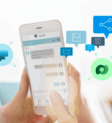4 Ways Chatbots Are Making Life Easier for Remote Workers

In 2021, artificial intelligence will recover 6.2 billion hours of worker productivity globally.
~ Gartner
When the COVID-19 pandemic began last year, organizations had to face a startling reality – “business as usual” was no longer the norm. Instead, within a couple of days, the entire global workforce shifted to working from remote locations.
For most businesses, their existing processes weren’t capable of handling this change. Employees struggled with connectivity, accessibility, and various other IT issues. HR teams had their email boxes full of questions from employees worried about work status, paycheck, and lack of procedural clarity.
In short, employees had many queries, and they couldn’t wait for long to get answers to the most urgent ones. Organizations soon realized that most of these queries were similar, specific questions that were frequently emerging.
Consequently, they decided to optimize support for commonly asked questions by deploying AI-enabled chatbots. Such chatbots leverage advanced technologies, such as machine learning (ML) and natural language processing (NLP), to provide human-like support, guide users to relevant knowledge-based articles, and walk them through steps to solve simple issues, for example, changing the system password. However, besides solving routine queries, chatbots cater to various use cases that help elevate the overall employee experience.
This blog talks about the future of work and the numerous ways in which chatbots are making life easier for remote workers.
The Future of Work
One year into the pandemic, and it’s clear – remote working is here to stay. A survey done by Gartner has shown that 82% of company leaders plan to allow employees to work remotely some of the time. Moreover, 59% of workers indicate they agree more with the statement, “I would only consider a new position or job that allows me to work from a location of my choice.”
While organizations like Deloitte UK have already announced flexible working for their entire workforce, a few like JPMorgan Chase still feel there is no substitute for the office.
Workplace dynamics have changed completely, and it is unlikely that the entire workforce will return to the office. In other words, the future of work will be a hybrid working model – a mix of traditional office-based work and remote working.
In such a scenario, delivering an exceptional employee experience (EX) becomes a crucial differentiator for organizations looking to acquire and retain the best talent and achieve higher customer satisfaction and better bottom-line results.
As seen above, AI-powered chatbots have become ubiquitous in the employee experience space, helping organizations simplify everyday work for their remote employees. Let’s understand further.
4 Ways Chatbots Are Making Life Easier for Remote Workers
1. Answer employee queries instantly - irrespective of where they work from!
As seen above, a shift to remote working increased incoming queries to employee help desks as remote workers dealt with connectivity issues, confusion about new workflows, and questions related to HR matters.
An AI-enabled chatbot fathoms user intent and can answer simple and complex queries alike – 24X7, at scale, and with minimal cost to the organization.
Users can ask queries from anywhere using mobile messaging apps – whether they are at home, in the office, or traveling somewhere – and get instant responses, increasing their overall efficiency and simplifying remote work.
The chatbot can provide personalized responses to questions like, “What is my leave balance?” Or, it can guide the user step-by-step to the end result for issues like, “How can I establish a VPN connection?”
If needed, the chatbot can also automatically escalate the issue/request to a human support agent.
2. Simplify and automate repetitive/everyday tasks for enhanced productivity
As employees work remotely and counter daily issues, hundreds of tickets are being received by the employee help desks, making it difficult for the staff to focus on tasks that add business value.
By leveraging technologies like robotic process automation (RPA), chatbots automate mundane, time-consuming tasks, such as generating IT tickets, updating the sales database, completing log reports, etc.
Additionally, remote employees can use chatbots to simplify everyday tasks like applying for leaves, booking business travel, issuing asset requests, etc.
3. Fetch required information quickly - anytime, anywhere!
Quick and seamless knowledge discovery is handy for employees, particularly the remote staff, as it helps boost productivity and reduce burnout.
Chatbots help employees fetch files, documents, FAQ pages, or other information from anywhere across the organization’s digital workplace – including all internal and external apps within the organization.
4. Send personalized alerts to increase remote employee engagement.
Remote employees work in silos. Lack of social interaction and problems in collaboration often take a toll on their physical and emotional well-being.
Chatbots can push personalized alerts and notifications to remote employees to increase employee engagement and alleviate work-related stress.
From upcoming events and news to issues requiring employee attention (e.g., a scheduled IT downtime, documents added, latest policy changes, and much more), chatbots can send notifications to the concerned employees depending on their role, geography, interests, etc.
A Remote Employee Experience Chatbot for Every Use Case
A) IT Chatbot
- Manage service disruptions and initiate upgrades, remediation workflows, and software fixes.
- Answer standard IT queries, e.g., “How to reset the system password?”
- Simplify and automate IT onboarding processes – allocating preferred laptops to new users, setting up email accounts, etc.
- Automate other IT tasks, including sending outage alerts, wiping off stolen laptops, and issuing asset request notifications.
B) HR Chatbot
- Provide answers to queries regarding salary, leave balance, income tax, yearly holidays, policies, etc.
- Automate recruiting and onboarding activities (screening candidates, collecting document proofs, scheduling interviews, etc.)
- Allow employees to apply for leave, book business travel (flights, hotel, etc.), and much more.
C) Data Analyst bot
- Fetch required data from the Business Intelligence (BI) app via text or multimedia (graphs and dashboard images). For example, “What were the sales of Product A in Q1-18?
- Send requested BI reports to the employee’s email id.
D) Intranet Chatbot
- Search and retrieve documents, files, and other content from anywhere across the company’s knowledge base.
- Get personalized, contextual, and meaningful search results from enterprise-wide tools and apps.
How Can An Aggregator Bot Ensure a Seamless Remote Working Experience?
With the growing usage of employee-facing chatbots, every internal department wants to build and deploy its own chatbot. Such chatbots cater to their function’s unique use cases and help remote employees solve different issues. However, the problem with having separate chatbots for HR, IT, BI, etc., is that employees must adapt to varying interfaces, conversation styles, and bot personas and remember the capabilities of each of these bots.
Moreover, if an organization deploys multiple bots, the cost of building, training, and maintaining such bots is significantly higher too.
An aggregator bot, sometimes known as a universal or concierge bot, provides a consistent employee experience by linking individual bots (also known as Child bots) to create a Master bot. It elevates remote employee experience by functioning as a personalized Virtual Employee Assistant (VEA).
When an employee types in a query, it first reaches the Master bot. The Master bot checks for authorization and permission levels and passes on the request to the specialized child bot (IT, HR, etc.)
Implementing an aggregator bot saves the cost of building and training multiple bots. Moreover, any feature enhancements done in the Master bot can be leveraged by the Child bots.
How can Acuvate help?
At Acuvate, we help clients make life easier for remote workers by deploying employee-facing chatbots for various use cases, including IT, HR, Business Intelligence, intranet, etc., with our low-code enterprise bot-building platform BotCore.
As a Microsoft Gold Partner, we use the best of Microsoft’s AI, machine learning, and natural language processing technologies, including LUIS, Azure Cognitive Services, and the Microsoft Bot Framework, to build chatbots for enterprises.
Our bots are omnichannel and multilingual, and support all popular enterprise messaging channels (Teams, Slack, ProofHub, etc.) and languages including French, German, English, Italian, etc.
We also deploy aggregator bots to help our clients deliver consistent and seamless engagement to remote employees.
To know more about BotCore, please feel free to schedule a personalized consultation with our chatbot experts.
Abhishek is the AI & Automation Practice Head at Acuvate and brings with him 17+ years of strong expertise across the Microsoft stack. He has consulted with clients globally to provide solutions on technologies such as Cognitive Services, Azure, RPA, SharePoint & Office 365. He has worked with clients across multiple industry domains including Retail & FMCG, Government, BFSI, Manufacturing and Telecom.






Abhishek Shanbhag